Zamia amplifolia is a species of plant in the family Zamiaceae. It is endemic to the Calima River watershed of Valle del Cauca Department, Colombia. It is threatened by habitat loss.
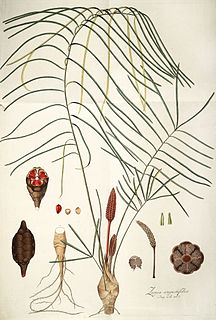
Zamia angustifolia is a species of plant in the family Zamiaceae. It is found in the Bahamas and Cuba. It is threatened by habitat loss.

Zamia chigua is a species of plant in the family Zamiaceae. It is found in Colombia and Panama. Its natural habitat is subtropical or tropical moist lowland forests.
Zamia cremnophila is a species of plant in the family Zamiaceae. It is endemic to the state of Tabasco in Mexico, between Teapa and Tapijulapa.
Zamia disodon is a species of plant in the family Zamiaceae. It is found in Colombia and Peru. It is threatened by habitat loss.
Zamia lacandona is a species of plant in the family Zamiaceae. It is endemic to Mexico, where it occurs only in the state of Chiapas, near Palenque and Agua Azul.
Zamia lucayana is a species of plant in the family Zamiaceae. It is endemic to the Bahamas, where it occurs on southeastern Long Island near Clarence Town and Turtle Cove. It is endangered by habitat loss.
Zamia macrochiera is a species of plant in the family Zamiaceae. It is endemic to Peru. It is found near the towns of Pebas and Pucaurquillo in Maynas Province, Loreto Region; plants are found near the Rio Amiyacu and Rio Napo. It is threatened by habitat loss, and is considered critically endangered by the IUCN.
Zamia montana is a species of plant in the family Zamiaceae. It is endemic to Antioquia Department, Colombia. Its natural habitat is subtropical or tropical moist montane forests. Zamia montana is extremely rare and is unknown in cultivation. Its habitat is also extremely threatened by logging activities. In fact, it may well be extinct in the wild because the only known population occurs in an area that was recently logged.
Zamia monticola is a species of plant in the family Zamiaceae. It is endemic to Guatemala. It is threatened by habitat loss.
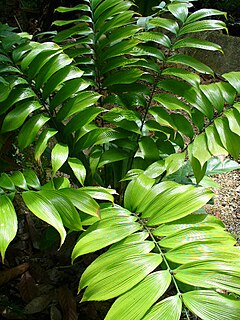
Zamia neurophyllidia is a species of plant in the family Zamiaceae. It is found in Costa Rica, Nicaragua, and Panama. It is threatened by habitat loss due to human presence.
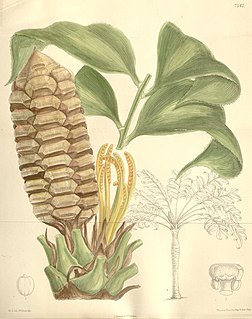
Zamia obliqua is a species of plant in the family Zamiaceae. It is found in Colombia and Panama. Its natural habitat is subtropical or tropical moist lowland forests. It is threatened by habitat loss.

Zamia portoricensis, the marunguey, is a species of plant in the family Zamiaceae. It is endemic to Susua State Forest region of western Puerto Rico.
Zamia prasina is a species of plant in the family Zamiaceae. It is endemic to Belize, where it occurs in the Columbia River Forest Reserve. Its natural habitat is subtropical or tropical moist montane forests. It is threatened by habitat loss.

Zamia pseudoparasitica is a species of plant in the family Zamiaceae. It is endemic to Panama. Its natural habitat is subtropical or tropical moist lowland forests on the Atlantic side of the isthmus. It is threatened by habitat loss.
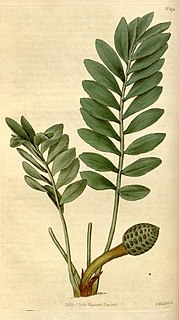
Zamia pygmaea is a species of plant in the family Zamiaceae found only in Cuba. It is the smallest living cycad. It is listed as critically endangered on the IUCN Red List based on its limited distribution, severely fragmented habitat, and population of less than 250 mature individuals.
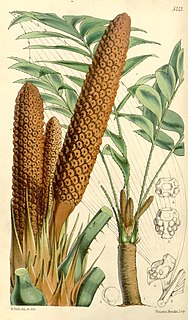
Zamia skinneri is a species of plant in the family Zamiaceae. It is endemic to the coastal area of mainland Bocas del Toro Province, Panama. Its common name is cebolla roja.

Zamia standleyi is a species of plant in the family Zamiaceae. It is endemic to Honduras, and is threatened by habitat loss.

Zamia wallisii is a species of plant in the family Zamiaceae. It is endemic to Colombia. Its common name is chigua.

Zamia erosa is a species of cycad native to the Caribbean islands of Jamaica, Cuba, and Puerto Rico, described by Orator Fuller Cook and Guy N. Collins in 1903. The species formerly known as Z. amblyphyllidia was determined in 2010 to be the same species as Z. erosa. It is listed as vulnerable by the IUCN Red List.











